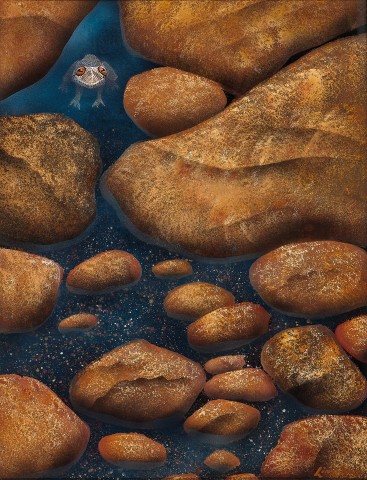GARKMAN, 1992
LIN ONUS
gouache on illustration board
50.0 x 37.5 cm
signed lower right: Lin Onus
Gallery Gabrielle Pizzi, Melbourne (label attached verso)
Private collection, Melbourne, acquired from the above in 1992
The Barmah Forest on the Victorian banks of the Murray River was Lin Onus' ancestral country and spiritual home. Born the son of a Scottish mother and a Yorta Yorta man from the Aboriginal mission of Cummerangunja near Echuca, Onus would regularly return to his father’s county where he would sit along the banks of the Murray River looking out over the Barmah Forest and its great trees reflected in the mirrored waters. He began painting during the 1970s, coinciding with both the acknowledgment of Aboriginal art in Australia and the emergence of the political debate on issues of native title and equal opportunity. Straddling such dualistic perspectives – one Western and representational, the other Aboriginal and spiritual – Onus was thus able to explore fresh ideas from a diverse range of influences.
Of particular relevance to his ‘water and reflection’ paintings such as the present, were Onus’ regular spiritual pilgrimages to Arnhem Land which, he later mused, gave him ‘back all the stuff that colonialism had taken away.’1 As Neale observes, ‘...now, in addition to his own ancestral site at Barmah forest he was permitted to access new sites of significance such as Arafura Swamp, or his adoptive community at the outstation Garmedi; to kinship systems in which he and his family were assigned skin names; to language that he used for many of the titles of his works; to ceremony and Dreaming stories.’2 Arguably most influential upon his stylistic evolution, however, was the relationship he developed in Arnhem Land with the highly esteemed Aboriginal painter, Jack Wunuwun. Inspired by the older artist's bark painting techniques such as rarrk (cross-hatched designs), Onus subsequently embarked upon his celebrated series of watery landscapes which, rich in reflections and ambiguities, substituted the traditional European panoramic view for one described by his mentor Wunuwun as ‘seeing below the surface.’ The presence of indigenised frogs within the landscape as in this painting refers also to totemic landscape and is part of Onus claiming custodianship or expressing a sense of belonging.
1. Neale, M., Urban Dingo: The Art of Lin Onus 1948 – 1996, Queensland Art Gallery, Brisbane, 2000, p. 15
2. Ibid., pp. 15 – 16
